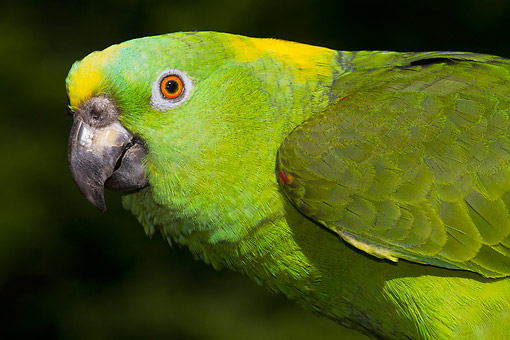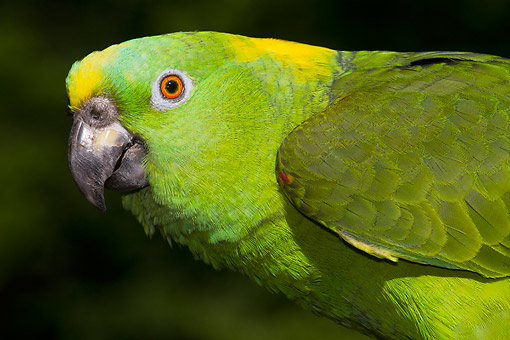ANIMAL: Yellow-Naped Amazon Amazona auropalliata Type of Animal: Parrot Habitat: Forests, woodlands, tropical areas, dry scrubland, forest clearings, savanna, mangroves, second growth in agricultural areas Location(s): Pacific coast of far S Mexico to NW Costa Rica, also in SE Honduras/NE Nicaragua Appearance: Green coloration w/ yellow band across lower nape/hindneck, dark gray bill/feet, reddish-orange eyes, immatures lack yellow nape feathers Food/Diet: Fruit, seeds, berries, nuts, blossoms, leaf buds, pollen, agricultural crops, insects Status in Wild: Endangered Conservation: Breeding in zoos, aquariums, aviculture, & wildlife centers. In SW Nicaragua, Paso Pacifico has incentive program paying community members to protect nests. For each successful fledgling, farmers paid more than twice as much what bird would be sold for on black market. Designing artificial nest boxes & planting trees w/ desirable food in parrot habitat. Lifestyle: Flocks of 2-50 birds. Break off into monogamous pairs for breeding/nesting season. Additional Info: Called: Male: Cock Female: Hen Young: Chick Group: Flock Weight: Adult: 1 lb Young: 3 oz Gestation: 1 month Life Span: 20-30 years in wild, 60-80 years in captivity Height: 1.125 ft Body Length: 1.125 ft Tail Length: 0.5 in Main predators are raptors, felids, canids, snakes, crocodilians, & coatis. Endangered due to pet trade, habitat loss/destruction, & logging. They’re cavity nesters. Sexually mature at 1.5-2 years old. They’re very loud birds, producing range of whistling calls/metallic shrieks/squawks/screams. Breeding pairs perform duet calls. Females lay 3-4 eggs per clutch, w/ chicks leaving nest at 3-4 months old. Like many parrots, they can cling to branches for a long time & even swing/hang upside down from them. One rare mutation occurring in captivity is blue w/ white nape. Also called Yellow-Naped Parrots & Golden-Naped Amazons. Active during the day (diurnal). Fun Fact(s): Very popular pets & known to be great talkers, readily mimicking sounds/human speech/human song. Also sought after for playful personalities & intelligence. Best talkers of all Amazons. Many YouTube videos show their singing/talking abilities. Young adult males can be aggressive & pairs can be very nest protective, especially dad. Females often much friendlier/nicer than males. Like many parrots, they often closely bond w/ 1 person, often being jealous of others. In some areas of Guatemala, El Salvador, & Costa Rica, poaching of parrot chicks has reached 100% due to high demand for pet trade. Always buy parrots from captive-bred, reputable source so less parrots are taken from wild.

